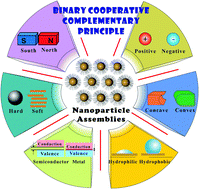A new view for nanoparticle assemblies: from crystalline to binary cooperative complementarity
Abstract
Studies on nanoparticle assemblies and their applications have been research frontiers in nanoscience in the past few decades and remarkable progress has been made in the synthetic strategies and techniques. Recently, the design and fabrication of the nanoparticle-based nanomaterials or nanodevices with integrated and enhanced properties compared to those of the individual components have gradually become the mainstream. However, a systematic solution to provide a big picture for future development and guide the investigation of different aspects of the study of nanoparticle assemblies remains a challenge. The binary cooperative complementary principle could be an answer. The binary cooperative complementary principle is a universal discipline and can describe the fundamental properties of matter from the subatomic particles to the universe. According to its definition, a variety of nanoparticle assemblies, which represent the cutting-edge work in the nanoparticle studies, are naturally binary cooperative complementary materials. Therefore, the introduction of the binary cooperative complementary principle in the studies of nanoparticle assemblies could provide a unique perspective for reviewing this field and help in the design and fabrication of novel functional nanoparticle assemblies.



 Please wait while we load your content...
Please wait while we load your content...